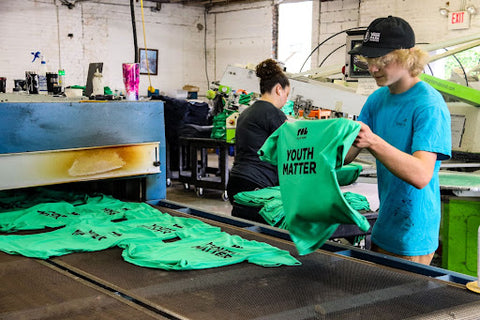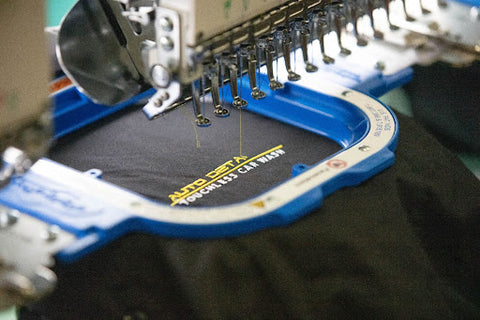When you think of a custom tee, you picture clothing that’s fun, fresh, and cozy.
Since it’s custom, it must also:
- Be stylish
- Be durable
- Have a vibrant design
You don’t want to print your brand on a scratchy, ill-fitting t-shirt either. You’ll end up with a stash of tees no one will ever wear.
A major selling point for a t-shirt is that it’s comfortable.
Your t-shirts should catch people’s eyes. Custom t-shirts can also be a proud form of self-expression and an invaluable megaphone for your mission.
Want your t-shirt to act as your very own wearable elevator pitch? Nothing does a better job of showing what you stand for, or what makes you you, than a custom printed tee.
If you want to foster a sense of unity and togetherness, then you’ll understand the logic behind brand colors and teams wearing uniforms. There’s no better way to say “unity” than to have everyone wear the same t-shirt.
Team-building events will never be the same once you’ve given your colleagues custom tees.
However, these tees won’t feel inspiring if you didn’t take the time to get a quality product.
On that note, there are certain must-have quality features to check for when buying custom t-shirts:
1 - High-Quality Fabric
Did you know? The easiest way to check if your t-shirt is made using high-quality fabric is to simply touch it.
T-shirts made with good quality material have fabric that feels smooth but firm. It’s a red flag if your custom tee feels rough or like plastic.
However, quality is subjective and can vary from person to person.
Since everyone has a different mark of quality, some people prefer thick cotton shirts while others prefer thinner, softer blended shirts.
At the end of the day, shirt quality becomes obvious once you touch and feel it.
This makes it all the more important to trust the company you work with to make your custom t-shirts.
The table below describes a few steps you can take to evaluate shirt quality:
| What to Do | What It Means |
| Check the fabric’s density by holding it against a light source | The more transparent the shirt is, the less dense the fabric is |
| Crumple part of the t-shirt tightly in your hand, then release it |
|
Expert Tip: It’s a fact that 100% cotton t-shirts produce the most vibrant colors. This is because their natural fibers bond well with the ink used in the printing process.
As for 50/50 cotton/polyester t-shirts, 50% of their fabric is synthetic.
Polyester is made of plastic, meaning that its fibers are not open and porous. Yes, they can be printed and the result is good, but the ink won’t have the same vibrancy that it does when used on 100% cotton.
Then there are tri-blend t-shirts made from a blend of cotton, polyester, and rayon fibers. These shirts are light, super soft, and less likely to shrink when washed (compared to 100% cotton tees). They stretch as you move, but otherwise keep their original shape.
These characteristics make tri-blends an excellent choice for custom screen printed designs, particularly those faded, or naturally heathered, vintage-style prints.

2 - Top-Notch Printing and Embroidery
Your custom t-shirts might be made using the best quality fabric available. But if the custom screen printing or embroidery job isn’t up to par, you can forget about promoting your brand.
In the case of a custom print job, the most common type of deterioration you’ll see is cracking in the print.
Here’s how to check the print quality of a shirt:
- Look for cracks and peeling in the corners and throughout the printed design. You’ll likely spot flaws if the printing has been done by an amateur.
- Touch the print to get a feel of the amount of ink and coated layers that have been applied. If the area feels thick, this indicates that excess ink was printed, which can increase the design’s chance of cracking.
- Stretch the inked design to verify that the print has been properly cured. The ink should stretch along with the fabric. Cracking means that curing wasn’t done properly, and that the print will soon wash away.
- Confirm the design isn’t already losing color by touching it and rubbing your fingers against it. If your fingers are stained, your t-shirt’s print quality isn’t top-notch.
- Touch the print to make sure that it feels nice and soft. If the print feels rough or scratchy, then the ink won’t last long.
Expert Tip: It’s possible to make a good quality print that you won’t feel thanks to vintage screen printing techniques. This process gives you a super soft-hand feel which makes for an incredibly soft shirt.
A second advantage is that vintage shirts are a trend which has been in style for decades and will build customer and brand loyalty.
Additionally, if you opt for water-based inks rather than plastisol inks (which are made of plastics), water-based inks are much more eco-friendly.
In the case of embroidered t-shirts, you can determine their quality by checking whether the finished design has holes or lose threads in it.
Additionally:
- Check for any loose threads on the embroidered artwork, then rub your nails and fingertips gently over the design to see if any threads emerge.
- Turn your custom t-shirt inside out and check how well the embroidery was done.
- Check if there’s a protective fabric, or what we call backing, that covers the back of your embroidery. Backing tends to make the designed artwork more durable over time by providing structure to the embroidered surface. They also reduce any itching that might happen when the design rubs against your skin.
3 - Sturdy Construction
Good quality fabrics and printing or embroidery make for a good quality tee. But it’s equally important to ensure your t-shirts are properly constructed, or else they’ll fall apart.
Therefore, inspect the knitting and stitching that comes with your tees to verify their strength and durability. There are a few checks you can do to confirm your t-shirts’ quality, including:
- Checking the seams and hems to ensure no threads are missing
- Checking the collar, the sleeves, and the lower hem for any signs of poor manufacturing
- Checking the number of stitches the garment has. Usually, the higher the number of stitches, the better the quality
- Turning the shirt inside out to confirm it’s evenly stitched and that it lies flat without any loose threads. The seams should stay straight to ensure the t-shirt doesn’t feel uncomfortable for the wearer
Put Your Brand on High-Quality Custom T-Shirts
You might be looking for branded tees to promote team building, or perhaps to engage and persuade your t-shirt audience to become your brand ambassadors.
You might be looking to sell some branded merch—it’s a great way to create an extra revenue stream while building up some hype and momentum for your company.
Whatever the case, ensuring your custom tees are the best quality is a critical first step. That’s why it’s important to partner with folks who understand what it takes to make custom screen-printed or embroidered tees that you’ll be proud to sell or give away.
Here’s what Principal Nick Green at Incarnation School had to say about fancysweetstx, which is his go-to place for all of his school’s customized apparel needs:
Think this review is too good to be true?
Check out this collection of 16153 Genova, Ohio, Michigan, Great Lakes, and Midwest t-shirts. It’ll give you a taste of the great quality and excellent fit you can expect when you choose fancysweetstx.
Share on Facebook:















Comments
Write a comment